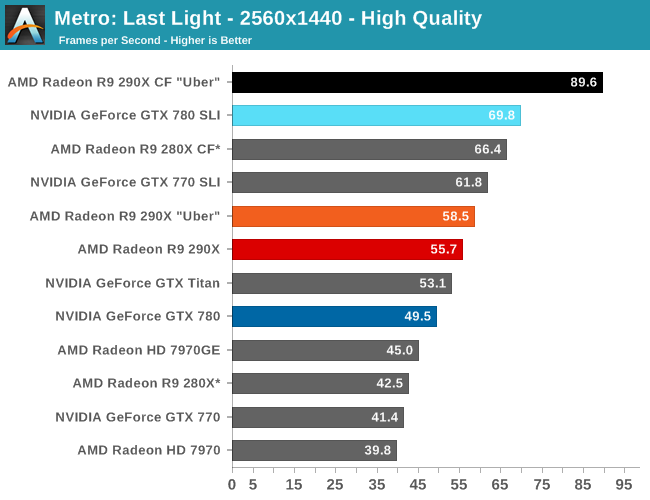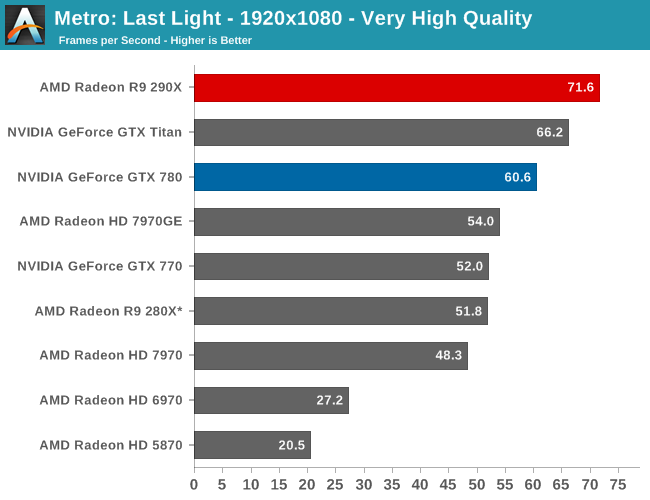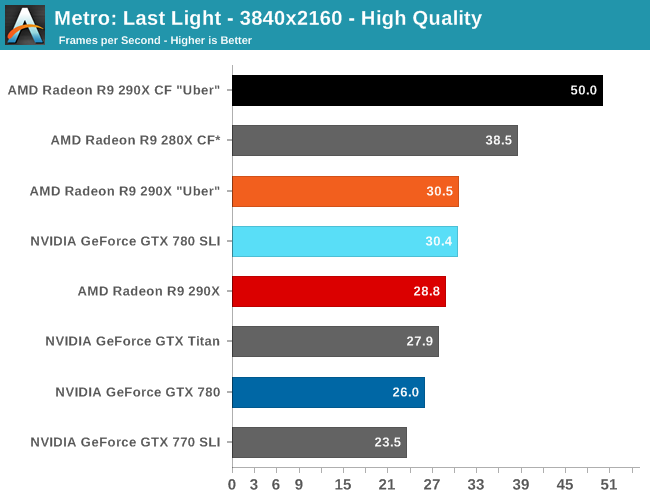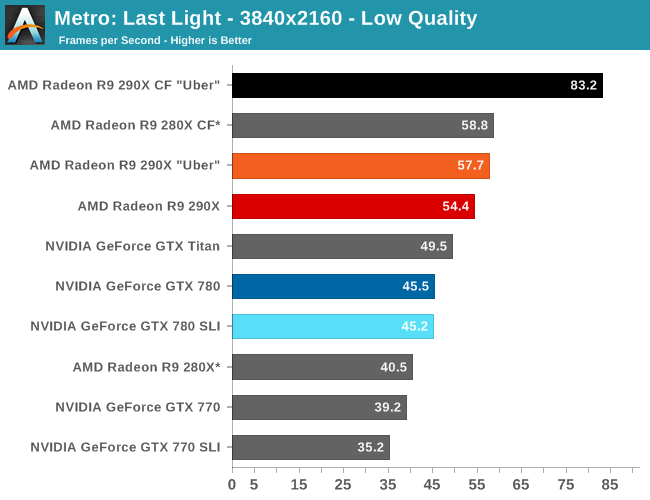The AMD Radeon R9 290X Review
by Ryan Smith on October 24, 2013 12:01 AM EST- Posted in
- GPUs
- AMD
- Radeon
- Hawaii
- Radeon 200
Metro: Last Light
As always, kicking off our look at performance is 4A Games’ latest entry in their Metro series of subterranean shooters, Metro: Last Light. The original Metro: 2033 was a graphically punishing game for its time and Metro: Last Light is in its own right too. On the other hand it scales well with resolution and quality settings, so it’s still playable on lower end hardware.


For the bulk of our analysis we’re going to be focusing on our 2560x1440 results, as monitors at this resolution will be what we expect the 290X to be primarily used with. A single 290X may have the horsepower to drive 4K in at least some situations, but given the current costs of 4K monitors that’s going to be a much different usage scenario.
With that said, for focusing on 4K on most games we’ve thrown in results both at a high quality setting, and a lower quality setting that makes it practical to run at 4K off of a single card. Given current monitor prices it won’t make a ton of sense to try to go with reduced quality settings just to save $550 – and consequently we may not keep the lower quality benchmarks around for future articles – but for the purposes of looking at a new GPU it’s useful to be able to look at single-GPU performance at framerates that are actually playable.
With that said, starting off with Metro at 2560 the 290X hits the ground running on our first benchmark. At 55fps it’s just a bit shy of hitting that 60fps average we love to cling to, but among all of our single-GPU cards it is the fastest, beating even the traditional powerhouse that is GTX Titan. Consequently the performance difference between 290X and GTX 780 (290X’s real competition) is even greater, with the 290X outpacing the GTX 780 by 13%, all the while being $100 cheaper. As we’ll see these results are a bit better than the overall average, but all told we’re not too far off. For as fast as GTX 780 is, 290X is going to be appreciably (if not significantly) faster.
290X also does well for itself compared to the Tahiti based 280X. At 2560 the 290X’s performance advantage stands at 31%, which as we alluded to earlier is greater than the increase in die size, offering solid proof that AMD has improved their performance per mm2 of silicon despite the fact that they’re still on the same 28nm manufacturing process. That 31% does come at a price increase of 83% however, which although normal for this price segment serves as a reminder that the performance increases offered by the fastest video cards with the biggest GPUs do not come cheaply.
Meanwhile for one final AMD comparison, let’s quickly look at the 290X in uber mode. As the 290X is unable to sustain the power/heat workload of a 1000MHz Hawaii GPU for an extended period of time, at its stock (quiet settings) it has to pull back on performance in order to meet reasonable operational parameters. Uber mode on the other hand represents what 290X and the Hawaii can do when fully unleashed; the noise costs won’t be pretty (as we’ll see), but in the process it builds on 290X’s existing leads and increases them by another 5%. And that’s really going to be one of the central narratives for 290X once semi-custom and fully-custom cards come online: Despite being a fully enabled part, 290X does not give us everything Hawaii is truly capable of.


Moving on, let’s talk about multi-GPU setups and 4K. Metro is a solid reminder that not every game scales similarly across different GPUs, and for that matter that not every game is going to significantly benefit from multi-GPU setups. Metro for its part isn’t particularly hospitable to multi-GPU cards, with the best setup scaling by only 53% at 2560. This is better than some games that won’t scale at all, but it won’t be as good as those games that see a near-100% performance improvement. Which consequently is also why we dropped Metro as a power benchmark, as this level of scaling is a poor showcase for the power/temp/noise characteristics of a pair of video cards under full load.
The real story here of course is that it’s another strong showing for AMD at both 2560 and 4K. At 2560 the 290X CF sees better performance scaling than the GTX 780 SLI – 53% versus 41% – further extending the 290X’s lead. Bumping the resolution up to 4K makes things even more lopsided in AMD’s favor, as at this point the NVIDIA cards essentially fail to scale (picking up just 17%) while the 290X sees an even greater scaling factor of 63%. As such for those few who can afford to seriously chase 4K gaming, the 290X is the only viable option in this scenario. And at 50fps average for 4K at high quality, 4K gaming at reasonable (though not maximum) quality settings is in fact attainable when it comes to Metro.
Meanwhile for single-GPU configurations at 4K, 4K is viable, but only at Metro’s lowest quality levels. This will be the first of many games where such a thing is possible, and the first of many games where going up to 4K in this manner further improves on AMD’s lead at 4K. Again, we’re not of the opinion that 4K at these low quality settings is a good way to play games, but it does provide some insight and validationg into AMD’s claims that their hardware is better suited for 4K gaming.










396 Comments
View All Comments
TheJian - Friday, October 25, 2013 - link
Incorrect. Part of the point of gsync is when you can do 200fps in a particular part of the game they can crank up detail and USE the power you have completely rather than making the whole game for say 60fps etc. Then when all kinds of crap is happening on screen (50 guys shooting each other etc) they can drop the graphics detail down some to keep things smooth. Gsync isn't JUST frame rate. You apparently didn't read the anandtech live blog eh? You get your cake and can eat it too (stutter free, no tearing, smooth and extra power used when you have it available).MADDER1 - Friday, October 25, 2013 - link
If Gsync drops the detail to maintain fps like you said, then you're really not getting the detail you thought you set. How is that having your cake and eating it too?Cellar Door - Friday, October 25, 2013 - link
How so? If Mantle gets 760gtx performance in BF4 from a 260X ..will you switch then?Animalosity - Sunday, October 27, 2013 - link
No. You are sadly mistaken sir.Antiflash - Thursday, October 24, 2013 - link
I've usually prefer Nvidia Cards, but they have it well deserved when decided to price GK110 to the stratosphere just "because they can" and had no competition. That's poor way to treat your customers and taking advantage of fanboys. Full implementation of Tesla and Fermi were always priced around $500. Pricing Keppler GK110 at $650+ was stupid. It's silicon after all, you should get more performance for the same price each year. Not more performance at a premium price as Nvidia tried to do this generation. AMD is not doing anything extraordinary here they are just not following nvidia price gouging practices and $550 is their GPU at historical market prices for their flagship GPU. We would not have been having this discussion if Nvidia had done the same with GK110.inighthawki - Thursday, October 24, 2013 - link
" It's silicon after all, you should get more performance for the same price each year"So R&D costs come from where, exactly? Not sure why people always forget that there is actual R&D that goes into these types of products, it's not just some $5 just of plastic and silicon + some labor and manufacturing costs. Like when they break down phones and tablets and calculate costs they never account for this. As if their engineers are basically just selecting components on newegg and plugging them together.
jecastejon - Thursday, October 24, 2013 - link
R&D. Is R&D tied only to a specific Nvidia card? AMD as others also invest a lot in R&D with every product generation, even if they are not successful. Nvidia will have to do a reality cheek with their pricing and be loyal to their fans and the market. Today's advantages don't last for to long.Antiflash - Thursday, October 24, 2013 - link
NVIDIA's logic. Kepler refresh: 30% more performance => 100% increase in priceAMD's logic. GCN refresh: is 30% more preformance => 0% increase in price
I can't see how this is justified by R&D of just a greedy company squishing its more loyal customer base.
Antiflash - Thursday, October 24, 2013 - link
Just for clarification. price comparison between cards at its introduction comparing NVIDIA's 680 vs Titan and AMD's 7970 vs 290xTheJian - Friday, October 25, 2013 - link
AMD way=ZERO PROFITS company going broke, debt high, 6Bil losses in 10yrsNV way=500-800mil profits per year so you can keep your drivers working.
Your love of AMD's pricing is dumb. They are broke. They have sold nearly everything they have or had, fabs, land, all that is left is the company itself and IP.
AMD should have priced this card at $650 period. Also note, NV hasn't made as much money as 2007 for 6 years. They are not gouging you or they would make MORE than before in 2007 right? Intel, Apple, MS are gouging you as they all make more now than then (2007 was pretty much highs for a lot of companies, down since). People like you make me want to vomit as you just are KILLING AMD, which in turn will eventually cost me dearly buying NV cards as they will be the only ones with real power in the next few years. AMD already gave up the cpu race. How much longer you think they can fund the gpu race with no profits? 200mil owed to GF in Dec 31, so the meager profit they made last Q and any they might have made next Q is GONE. They won't make 200mil profit next Q...LOL. Thanks to people like you asking for LOW pricing and free games.
You don't even understand you are ANTI-AMD...LOL. Your crap logic is killing them (and making NV get 300mil less profit than 2007). The war is hurting them both. I'd rather have AMD making 500mil and NV making 1B than what we get now AMD at ZERO and NV at 550mil.